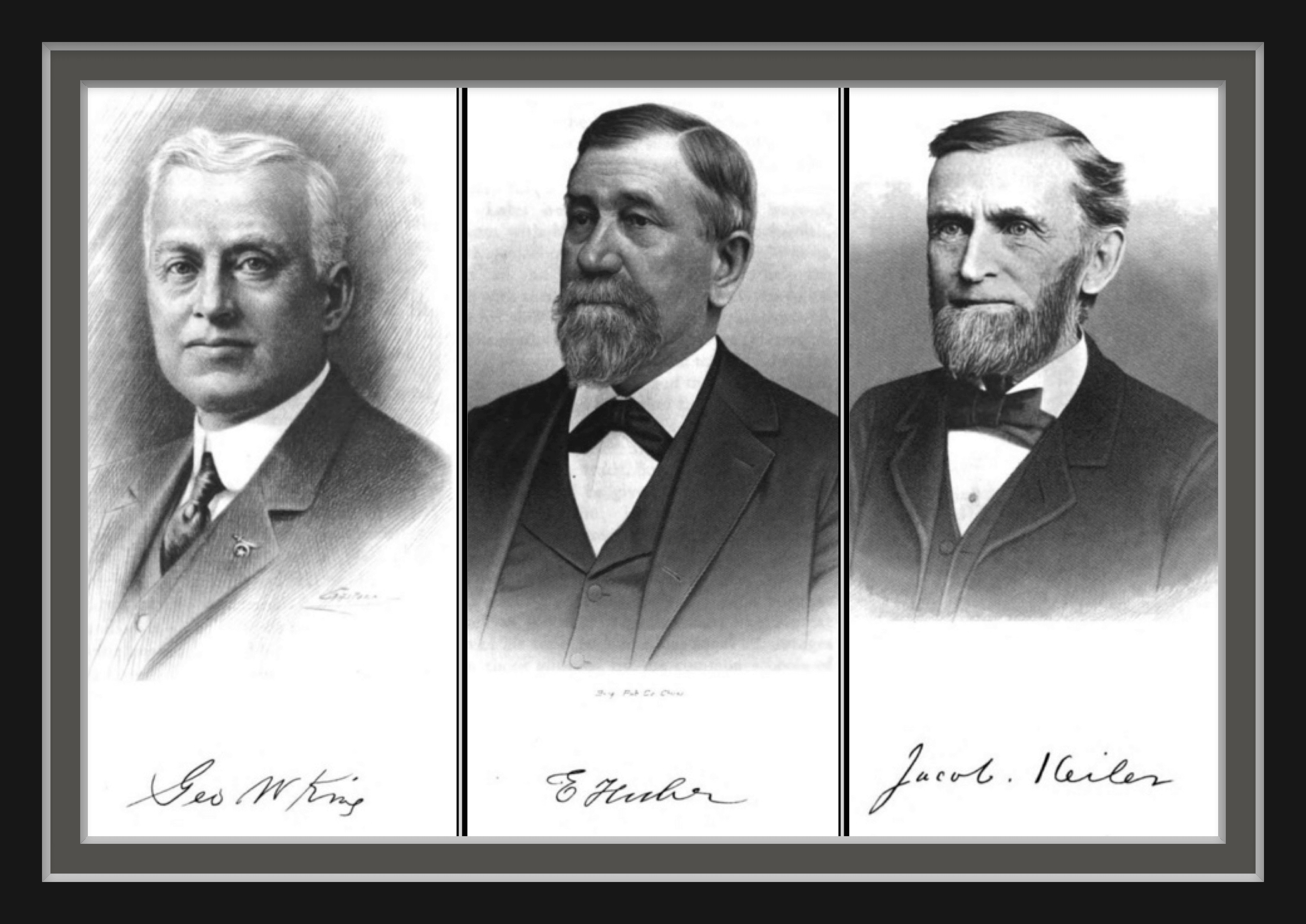
Headquarters:
Marion, OhioAlso sold under the names (if applicable): King
History:
 The Huber Hay Carrier was invented by GEORGE WASHINGTON KING (1854 – 1917) (a friend of EDWARD HUBER) and built in the Huber Manufacturing Company factory in Marion, Ohio. George Washington King was born in Richland Township, Marion County, Ohio. In 1882 King patented the hay carrier. In 1884 he co-founded the Marion Steam Shovel Company, which manufactured products such as steam shovels, road ditchers, and log loaders. The company was very successful in the late 19th and early 20th centuries, grew to over one thousand employees, and furnished shovels for the building of the Panama Canal. During his association with the company, King served as president, director, superintendent, engineer, and general manager.
The Huber Hay Carrier was invented by GEORGE WASHINGTON KING (1854 – 1917) (a friend of EDWARD HUBER) and built in the Huber Manufacturing Company factory in Marion, Ohio. George Washington King was born in Richland Township, Marion County, Ohio. In 1882 King patented the hay carrier. In 1884 he co-founded the Marion Steam Shovel Company, which manufactured products such as steam shovels, road ditchers, and log loaders. The company was very successful in the late 19th and early 20th centuries, grew to over one thousand employees, and furnished shovels for the building of the Panama Canal. During his association with the company, King served as president, director, superintendent, engineer, and general manager.
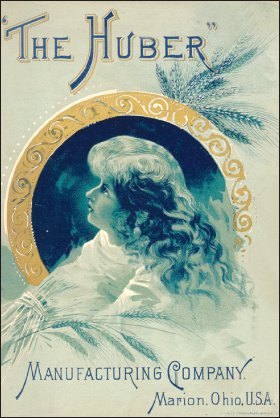 EDWARD HUBER (1837-1904) was born in Kelso, Dearborn County, Ind., September 1, 1837, and passed his boyhood on a farm near there. He was the youngest son of Phillip Huber, one of four brothers, who came to this country from Germany, Phillip being a cabinet maker, and after following his trade for a time, in the East, located on a farm near Kelso.
EDWARD HUBER (1837-1904) was born in Kelso, Dearborn County, Ind., September 1, 1837, and passed his boyhood on a farm near there. He was the youngest son of Phillip Huber, one of four brothers, who came to this country from Germany, Phillip being a cabinet maker, and after following his trade for a time, in the East, located on a farm near Kelso.
After several years on the farm, Mr. Huber was apprenticed to the trade of blacksmith, and while there was afforded an opportunity to study mechanics, a study which was to absorb his entire life.
In 1865 he went to Marion and in the same year he married Miss Elizabeth Hammerle, of Kelso, and shortly after the marriage her brother came to Marion, watchful for an opportunity to enter business.
The result was the organization of the firm of Kowalke & Hammerle. Mr. Huber was engaged as the superintendent of the manufacture of small articles and the planing mill business, which they established. In connection with the planing mill, the firm began the building of the Huber rake, and in due time the demand for the rake became such the partnership was-increased by the addition of Mr. Huber, who had been unable to enter the business sooner because of his inability to secure any money whatever. In due time the scope of the work was enlarged by the invention and construction of the revolving road scraper, which found a ready market.
Five years after Mr. Huber’s arrival in Marion, Mr. Hammerle retired from business. Mr. Kowalke had already retired, and the partnership of Huber, Gunn & Company was organized.
Mr. Huber had invented a steam engine, which was such a great improvement over anything on the market that it promised well, and the new partnership was formed to engage in engine manufacture. The succeeding four years brought some measure of success, the Huber engine being welcomed wherever it was introduced, and in 1874, the Huber Manufacturing Company was organized with a capital stock of $75,000. The company prospered, improvements were made, and in 1880, the organization turned its attention to the manufacture of threshing separators, as well as engines. When the first traction engine appeared in the field, Mr. Huber began his studies in that direction and soon after the Huber traction engine was an active competitor in the field, and was awarded the recognition which a superior article always receives.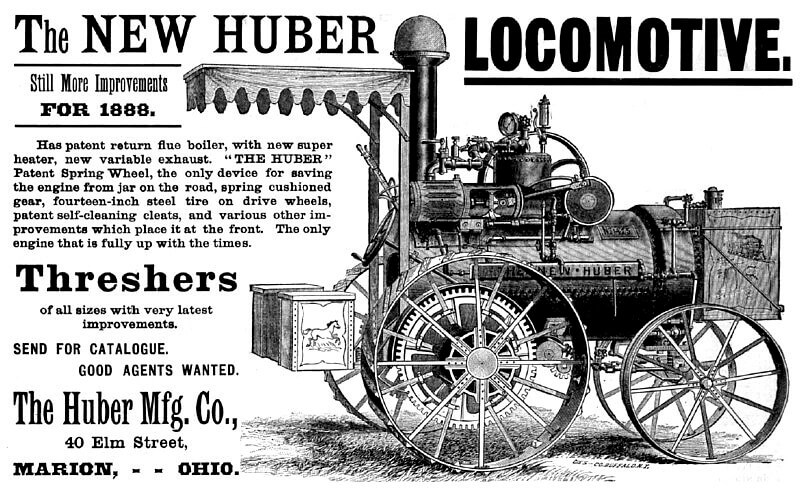
Within nine years the business had out grown its quarters in what is known to every one familiar with Marion as the old Huber shops, between Main and Prospect streets, and a change of location was made to the present site, which includes about twenty acres of shop buildings, and is one of the finest plants in the country. Some 700 workmen are employed and the company has a capitalization of $500,000.
The business of the company amounts to about $2,000,000 annually and Huber threshers and engines are not only used in every important wheat growing section of the United States, but are to be found in many quarters of the world.
At the time of his death Mr. Huber was president of the Huber Manufacturing Company, president of the Marion Steam Shovel Company, president of the Marion Malleable Iron Company, president of the Marion Implement Company, president of the Marion National Bank, vice-president of the Marion Milling Company and treasurer of the Marion Building and Loan Association. Until recently he was president of the Marion Electric Light Company and was a leading stockholder in the Marion Street Railway Company.
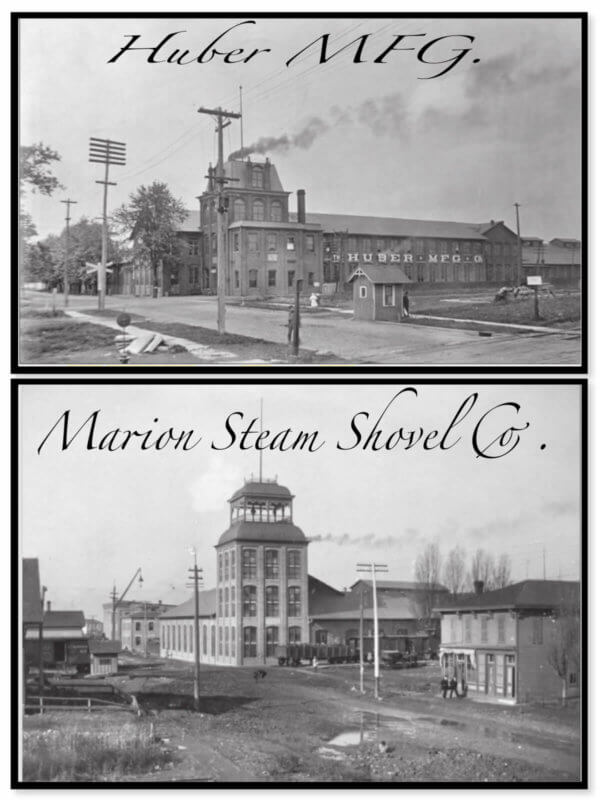 The following is a first hand account of how George Washington King invented and manufactured his hay carrier………”When I brought Mr. Huber the wooden model of a hay carrier that I had designed and put into operation in my father’s barn the previous summer, he became very much interested. With the carrier, hay could be lifted straight up from the wagon until it would clear the beams or other obstructions in the barn and then be carried back into the mow any required distance. I made this device to avoid a job that I disliked doing that of pitching hay from a wagon into a small door in the barn some distance from the ground while the hot sun was pouring down upon me. I explained the features of my hay carrier and told Mr. Huber what it had accomplished, and he informed me that the device was worthy of a patent and that he would assist me in procuring one and would pay the patent fees for one-half interest in it. I agreed to this proposition and a patent was granted me and issued April 25, 1882. I made the wood patterns for the new carrier and had the Huber Manufacturing Company make castings. I then hauled the castings to King’s Mills, where I assembled them. The Huber foundry was located between the Erie and Big Four railroads on North Main Street, Marion, which was not a very safe location to drive a spirited team, so I would hitch the team on Main Street near the Court House and then wheel the castings from the foundry to the place where my team was hitched. I had designed and installed in the old mill some ingenious machinery for making wood pulleys for these carriers, and as soon as I had completed the first few carriers I loaded one of them into a buggy and showed it to the farmers in the surrounding country. Most of them had heard of the work my carrier had accomplished, and I had very little trouble in making sales. Mr. Howard Brenner, a near neighbor, followed me, delivering the carriers and installing them in the barns for the farmers. In this way we did a good neighborhood business during the first season. At the end of the season, when making a settlement with Mr. Huber-and according to the agreement he was to share half of the profits, I had my first opportunity to learn the true character of the broad-minded man with whom I was dealing. I had made what I considered a reasonable charge for my work of making patterns, assembling and selling the carriers, but Mr. Huber said that I had not charged enough and insisted that I be allowed more, which I reluctantly consented to accept. He said that the patterns I had made were as good as those of a skilled pattern maker. This was my first business experience with Mr. Huber, but afterward I was closely associated with him in business until the time of his death, and I always found him to be perfectly fair and just in all his dealings. I found that no matter how much personal gain was at stake, he was always honest and reasonable. This is an exceptional trait and is found in but few men. In the following year Mr. Huber offered to sell me his interest in the hay carrier business, stating that I had to do all of the work and I could handle it just as well alone. He insisted that I should move to Marion and offered to rent me a room with power to do grinding and drilling, where I could assemble the carriers. He told me that he would continue to help me in the way of advice, as he thought I would be able to help him. He said, “We need you here in Marion, anyway.” I accepted his offer and moved to Marion, November 1, 1883.
The following is a first hand account of how George Washington King invented and manufactured his hay carrier………”When I brought Mr. Huber the wooden model of a hay carrier that I had designed and put into operation in my father’s barn the previous summer, he became very much interested. With the carrier, hay could be lifted straight up from the wagon until it would clear the beams or other obstructions in the barn and then be carried back into the mow any required distance. I made this device to avoid a job that I disliked doing that of pitching hay from a wagon into a small door in the barn some distance from the ground while the hot sun was pouring down upon me. I explained the features of my hay carrier and told Mr. Huber what it had accomplished, and he informed me that the device was worthy of a patent and that he would assist me in procuring one and would pay the patent fees for one-half interest in it. I agreed to this proposition and a patent was granted me and issued April 25, 1882. I made the wood patterns for the new carrier and had the Huber Manufacturing Company make castings. I then hauled the castings to King’s Mills, where I assembled them. The Huber foundry was located between the Erie and Big Four railroads on North Main Street, Marion, which was not a very safe location to drive a spirited team, so I would hitch the team on Main Street near the Court House and then wheel the castings from the foundry to the place where my team was hitched. I had designed and installed in the old mill some ingenious machinery for making wood pulleys for these carriers, and as soon as I had completed the first few carriers I loaded one of them into a buggy and showed it to the farmers in the surrounding country. Most of them had heard of the work my carrier had accomplished, and I had very little trouble in making sales. Mr. Howard Brenner, a near neighbor, followed me, delivering the carriers and installing them in the barns for the farmers. In this way we did a good neighborhood business during the first season. At the end of the season, when making a settlement with Mr. Huber-and according to the agreement he was to share half of the profits, I had my first opportunity to learn the true character of the broad-minded man with whom I was dealing. I had made what I considered a reasonable charge for my work of making patterns, assembling and selling the carriers, but Mr. Huber said that I had not charged enough and insisted that I be allowed more, which I reluctantly consented to accept. He said that the patterns I had made were as good as those of a skilled pattern maker. This was my first business experience with Mr. Huber, but afterward I was closely associated with him in business until the time of his death, and I always found him to be perfectly fair and just in all his dealings. I found that no matter how much personal gain was at stake, he was always honest and reasonable. This is an exceptional trait and is found in but few men. In the following year Mr. Huber offered to sell me his interest in the hay carrier business, stating that I had to do all of the work and I could handle it just as well alone. He insisted that I should move to Marion and offered to rent me a room with power to do grinding and drilling, where I could assemble the carriers. He told me that he would continue to help me in the way of advice, as he thought I would be able to help him. He said, “We need you here in Marion, anyway.” I accepted his offer and moved to Marion, November 1, 1883. 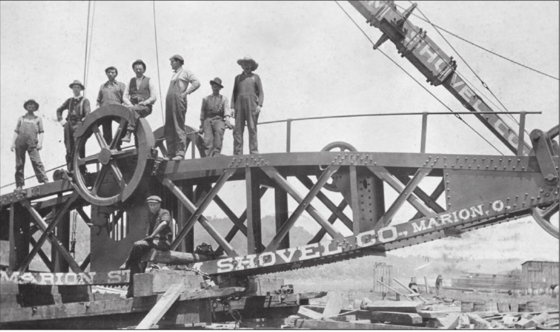 The savings I had accumulated up to that time, including the first five cents mentioned before, gave me a financial start in Marion. About this time Mr. Henry M. Barnhart had interested Mr. Huber in a new design of steam shovel that he had invented. Mr. Huber had proposed to Mr. Barnhart that he would take out the patent on his steam shovel device for a half interest, a proposition similar to the one he had made me. After preliminary steps had been taken and Mr. Huber had been advised that a patent could be secured, it was decided to have a steam shovel built in the Huber works. This shovel was erected on North Main Street, Marion, just north of the Big Four tracks and south of the old frame machine shop, which has since been destroyed by fire. A pattern maker was needed, and Mr. Huber, being familiar with my ability in that line of work, insisted that I help make patterns for the new shovel andemploy another man to assemble the carriers. This did not interfere seriously with my hay carrier Work, as the pattern work was done during the slack season of the carrier trade. I soon became so much interested in assisting Mr. Barnhart and Mr. Huber in the making of their first shovel that Mr. Barnhart prevailed upon me to room and board with him, where we could have a better opportunity to talk during the evenings, as we were both busily engaged at other work during the day. I appreciated this change very much, as Mrs. Barnhart and the balance of the family shared with me the hospitality of their home. Mr. Barnhart’s three oldest daughters were in the grammar grades at school and were very eager to assist me in carrying on my hay carrier correspondence. They would write circular letters while Mr. Barnhart and I were talking and planning. After the first shovel was completed it was sold to the Cincinnati, Jackson, and Mackinaw Railroad, and was put to work in a fine gravel bank near Greenville, Ohio. Mr. Barnhart, being a practical steam shovel runner, took charge of erecting the machine after it had reached its destination, and operated it until he could instruct an engineer. While he was engaged in starting and adjusting this new machine I again turned my attention to the hay carrier trade. My office was not very elaborate, being in the room that Mr. Huber had rented me for assembling the carriers, and was furnished with two boxes, one of which served as a desk and a place for stationery and another did service as a seat. A good many thousand dollars’ worth of business was transacted in this crude office, however.The panic of 1884 seriously affected the new company, and, had it not been for Mr. Huber, who frequently came to its rescue, using his personal credit, I doubt whether The Marion Steam Shovel Company would be in existence to-day.
The savings I had accumulated up to that time, including the first five cents mentioned before, gave me a financial start in Marion. About this time Mr. Henry M. Barnhart had interested Mr. Huber in a new design of steam shovel that he had invented. Mr. Huber had proposed to Mr. Barnhart that he would take out the patent on his steam shovel device for a half interest, a proposition similar to the one he had made me. After preliminary steps had been taken and Mr. Huber had been advised that a patent could be secured, it was decided to have a steam shovel built in the Huber works. This shovel was erected on North Main Street, Marion, just north of the Big Four tracks and south of the old frame machine shop, which has since been destroyed by fire. A pattern maker was needed, and Mr. Huber, being familiar with my ability in that line of work, insisted that I help make patterns for the new shovel andemploy another man to assemble the carriers. This did not interfere seriously with my hay carrier Work, as the pattern work was done during the slack season of the carrier trade. I soon became so much interested in assisting Mr. Barnhart and Mr. Huber in the making of their first shovel that Mr. Barnhart prevailed upon me to room and board with him, where we could have a better opportunity to talk during the evenings, as we were both busily engaged at other work during the day. I appreciated this change very much, as Mrs. Barnhart and the balance of the family shared with me the hospitality of their home. Mr. Barnhart’s three oldest daughters were in the grammar grades at school and were very eager to assist me in carrying on my hay carrier correspondence. They would write circular letters while Mr. Barnhart and I were talking and planning. After the first shovel was completed it was sold to the Cincinnati, Jackson, and Mackinaw Railroad, and was put to work in a fine gravel bank near Greenville, Ohio. Mr. Barnhart, being a practical steam shovel runner, took charge of erecting the machine after it had reached its destination, and operated it until he could instruct an engineer. While he was engaged in starting and adjusting this new machine I again turned my attention to the hay carrier trade. My office was not very elaborate, being in the room that Mr. Huber had rented me for assembling the carriers, and was furnished with two boxes, one of which served as a desk and a place for stationery and another did service as a seat. A good many thousand dollars’ worth of business was transacted in this crude office, however.The panic of 1884 seriously affected the new company, and, had it not been for Mr. Huber, who frequently came to its rescue, using his personal credit, I doubt whether The Marion Steam Shovel Company would be in existence to-day.
 It was during this panic that Mr. Huber, in order to prevent the closing down of the Huber Manufacturing Company’s works, arranged to have the Huber Company build two steam shovels for the Marion Steam Shovel Company, employing Mr. B. P. Sweney as foreman during their construction. On January 20, 1885, one of these shovels was sold to the Florida Railroad and Navigation Company. While Mr. Barnhart was in Florida starting this machine, Mr. Keiler offered to buy my carrier business. I had become so much interested in steam shovel work that I made him a reasonable price, but he said that he could not pay me cash as he had put all of his money into the steam shovel company. Steam shovel stock was not looking very attractive at that time, and I had made money manufacturing carriers, but I felt that there was a great future for shovels, so I agreed to take steam shovel stock in payment for my carrier business. Mr. Barnhart and Mr. Huber were very much elated when they learned that I had disposed of my carrier business.”
It was during this panic that Mr. Huber, in order to prevent the closing down of the Huber Manufacturing Company’s works, arranged to have the Huber Company build two steam shovels for the Marion Steam Shovel Company, employing Mr. B. P. Sweney as foreman during their construction. On January 20, 1885, one of these shovels was sold to the Florida Railroad and Navigation Company. While Mr. Barnhart was in Florida starting this machine, Mr. Keiler offered to buy my carrier business. I had become so much interested in steam shovel work that I made him a reasonable price, but he said that he could not pay me cash as he had put all of his money into the steam shovel company. Steam shovel stock was not looking very attractive at that time, and I had made money manufacturing carriers, but I felt that there was a great future for shovels, so I agreed to take steam shovel stock in payment for my carrier business. Mr. Barnhart and Mr. Huber were very much elated when they learned that I had disposed of my carrier business.”
JACOB KEILER (1832 – 1890), owner and operator of the planing mill, was born in Berlin County, Penn. , January 1, 1832. His parents were Jacob and Catharine (Cook) Keiler; the former died in Columbia County, Penn., in 1858, and the latter in Delaware County, Ohio, in July, 1870. When a boy, our subject learned the miller’s trade with his father. When of age, he took up the carpenter’s trade in Lycoming County, Penn., and worked two years. In 1857, he went to Marshall County, Iowa, where he worked at his trade until October, 1861, when he enlisted in Company H, Twelfth Regiment Iowa Volunteer Infantry; he served in the Army of the Tennessee, and participated in the following leading battles. Shiloh, Corinth, siege of Vicksburg and in all the engagements of the Atlanta campaign, including Atlanta, where he was taken a prisoner, July 22, 1864. He was confined in Andersonville Prison two months and Florence, S. C. , until December 12, 1864, when he was paroled. He was discharged at Davenport. Iowa, July 3, 1865. He came to Delaware and purchased an interest in the Delaware Flouring Mills; a year later he came to Marion and engaged in lumbering, and subsequently erected his planing mill, at a cost of $4,000. In October, 1868, he was married to Miss Sarah C. Harder, who died in October, 1877, leaving two children, Frank S. and Grace. His second marriage took place in June, 1881, with Mrs. Martha P. Elliott, widow of J. S. Elliott; she had two children by her former husband, namely, Lowell and Charles H.
